Volume 25
Black Hole or MECO: Central Singularities
Editors: Rudy E. Schild, Carl H. Gibson, N. Chandra Wickramasinghe
INTRODUCTION TO VOL. 25
by Editor-in-Chief Rudolph E. Schild
In Spring of 2014 a widely reported statement by Steven Hawking noted that black holes encountered in
Nature might exist in a “metastable quantum state.” Such objects would not have a true event horizon with infinite density, but instead would be dominated and bounded by an
“apparent horizon” that responds locally to its ever-changing quantum physics, (Hawking 2014
). Information Preservation and Weather Forecasting for Black Holes, pp 13086-13091,
commented by Carl H. Gibson (see page 13086 below). The 2010 Leiden workshop New Directions in Modern Cosmology,
Journal of Cosmology, Vol. 15, anticipated this need for new ideas. Hawking's new theory converges toward HGD-cosmology-turbulence ("new" turbulence) and HGD-big-bang-turbulent-combustion
("new" cosmology) models that result from improved fluid mechanics, and from vastly improved astrophysical and astro-biological observations.
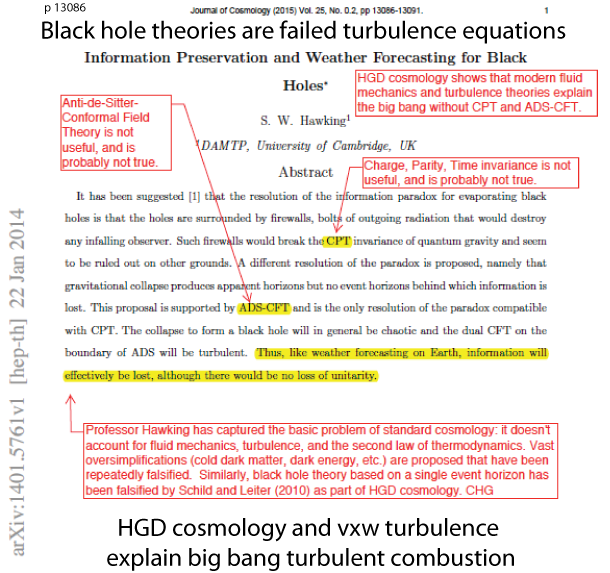
The black hole theory modifications by Steven Hawking created a heightened interest in the solutions of the Relativistic Quantum Field mathematics of Mitra (2000) applied to collapsed solutions whose equation of state closed the equations for the MECO solution of Robertson and Leiter (2002) that demonstrated a rotating solution with a strong surface magnetic field. Thus a co-rotation radius for the accretion disc in-spiral could be determined, and the spectral states characteristic of the radio-quiet versus radio-loud objects could at last be understood. The resulting luminous structures were shown to be a good fit to microlensing results from the 25-year brightness monitoring record by Schild, Leiter, and Robertson in 2006. Volume 25 of the Journal of Cosmology is dedicated to the study of traditional and MECO black hole theories and observations.
CENTRAL OBJECTS OF GALAXIES AND OTHER STAR CLUSTERS ARE OFTEN CLAIMED TO BE BLACK HOLES
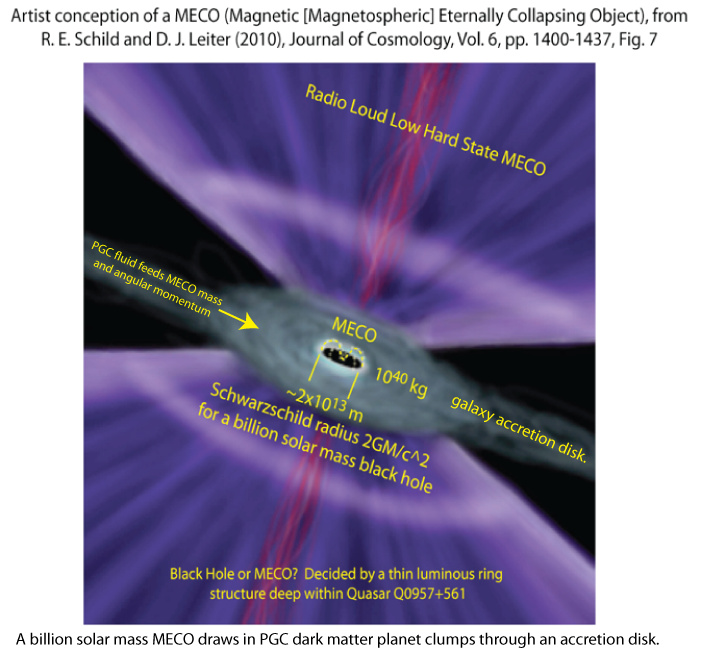
Figure JC2014.25.0.1 (CHG). Reprint of Schild and Leiter (2010, Journal of Cosmology, Volume 6, pp 1400-1437) (Gibson comments) pp 13000-13038 uses the nearly nanoarcsecond resolution of the first galaxy gravitational lens, quasar Q0957 + 561 A,B (Schild 1996), to test the generally accepted hypothesis that all galaxies have massive (> billion solar mass) central (Hawking-Thorne) black holes with event horizons from which no information can escape. The extreme resolution of the first lensed quasar permitted the detection of earth-mass planets as the dark matter of the lensing galaxy. Applied to the quasar source, unexpectedly small-scale reverberation frequencies appear that are equally revolutionary. From the Schild observations, the quasar does not behave as a black hole but as a MECO, raising the important question of whether the accepted Hawking paradigm of black holes has ever had any physical basis, anywhere or at any time. Small scale black holes have been proposed as the non-baryonic dark matter by Hawking and Carr. Questioning standard models of astrophysics like cold dark matter, dark energy, and black holes is a scientific declaration of war, as Stanford physicist Leonard Susskind has discovered.
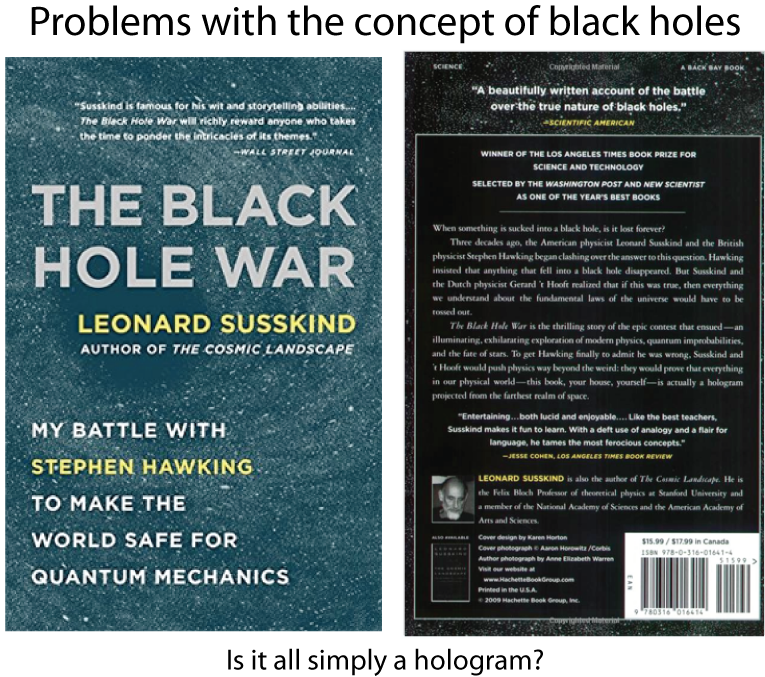
CONTENTS
I. COSMOLOGY
1. A NEW APPROACH TO THE QUASAR FUNDAMENTAL PLANE, Rudolph Schild and Darryl Leiter. pp 13042-13062.
2. COULD OUR UNIVERSE HAVE FEATURES OF A GIANT BLACK HOLE?, Eugene Terry Tatum, pp 13063-13072.
3. HOW A BLACK HOLE UNIVERSE THEORY MIGHT RESOLVE SOME COSMOLOGICAL CONUNDRUMS, Eugene Terry Tatum, pp 13073-13085
4. Marginal Evidence for Cosmic Acceleration from Type Ia Supernovae, Neilsen et al. (2015). No dark energy!, comments by Carl H. Gibson. pp 13092-13100. Nearly a thousand new Supernova Ia events show the statistical evidence for dark energy and an accelerating expansion of the universe is at best very weak. The dimness scatter that prompted the ill-fated claims of accelerated expansion of the universe driven by dark energy become more striking as more SNeIa events accumulate and their precision increases.
The large scatter of the supernova dimness observations is easily understood from HGD cosmology, where all stars form in PGC (protoglobularstarcluster) clumps of a trillion dark matter planets by binary mergers of the planets to form larger planets and eventually stars. The Hawking (2014) discussion about ADS/CFT and CPT should be understood as a complex and useless attempt to solve the turbulence problem mathematically or by numerical simulation. This has never worked in the history of turbulence research. To solve the turbulence problem, one must recognize a crucially important physical reality; that is, that turbulence is always dominated by inertial vortex forces or the fluid motion is not turbulence. Turbulence always starts at the Kolmogorov length scale L_K. From HGD cosmology, L_K is identical to the Planck scale 10^-35 meters for the big bang, as shown by Gibson (2004, 2005), and always cascades from small scales to large.
>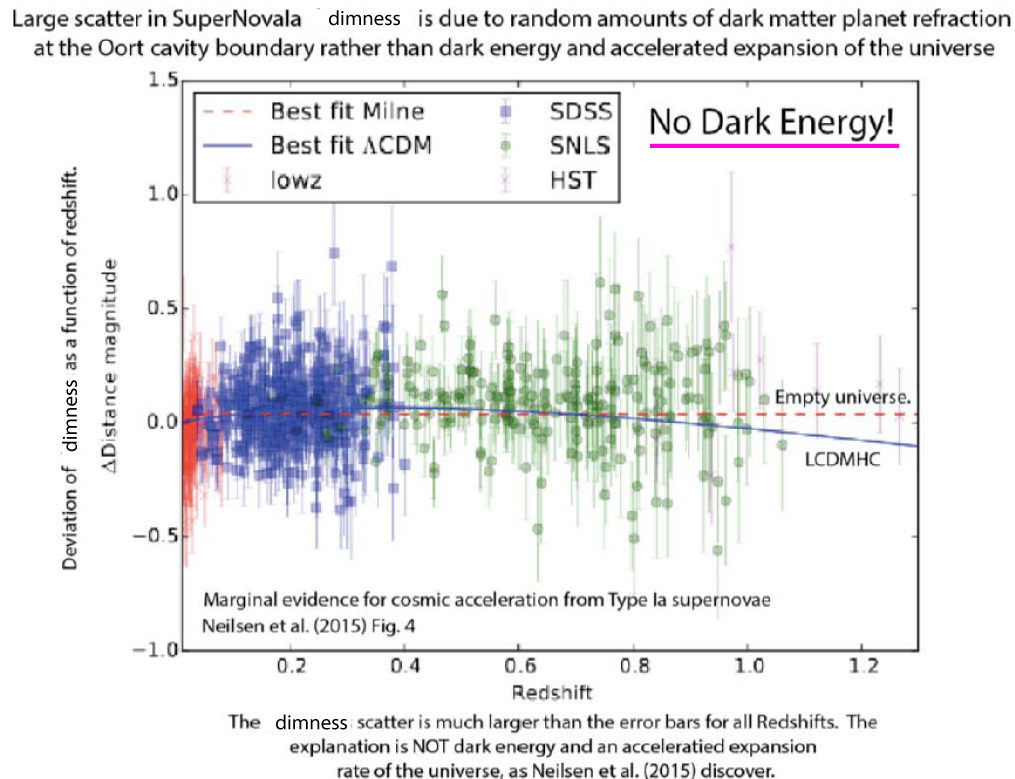
Figure JC2015.25.4.1 (CHG). Observations of new Supernova Ia events have improved the statistical evaluation of the LCDMHC claims that the universe expansion rate is accelerating from negative pressures of dark energy and its intrisically anti-gravity property. Neilsen et al. (2015) show that these claims are very marginally supported. No explanation is given for the wide scatter in the dimness of the events at all redshifts from 0 < z < 1, suggested as refractive scattering by Oort cavity dark matter planet density interfaces, from HGD cosmology. As indicated in the Figure, LCDMHC cosmology and dark energy are not supported by these observations. pp 13101-13103.
Figure JC2015.25.4.2 (CHG).Wei et al. (2015) reach the same conclusion as Neilsen et al. (2015). There is no evidence of dark energy or an accelerated expansion of the universe in Supernova Ia events. The quote is from the Abstract of Wei et al. (2015). The Figure is based on their Fig. 5. Conclusions from HGD cosmology are underlined in red. pp 13104-13106. Note that the scatter is much larger than the error bars, as expected if the SNe Ia dimness fluctuations result from refraction at the Oort cavity boundary. A commented version of Wei et al. (2015) is provided. pp 13108-13139.
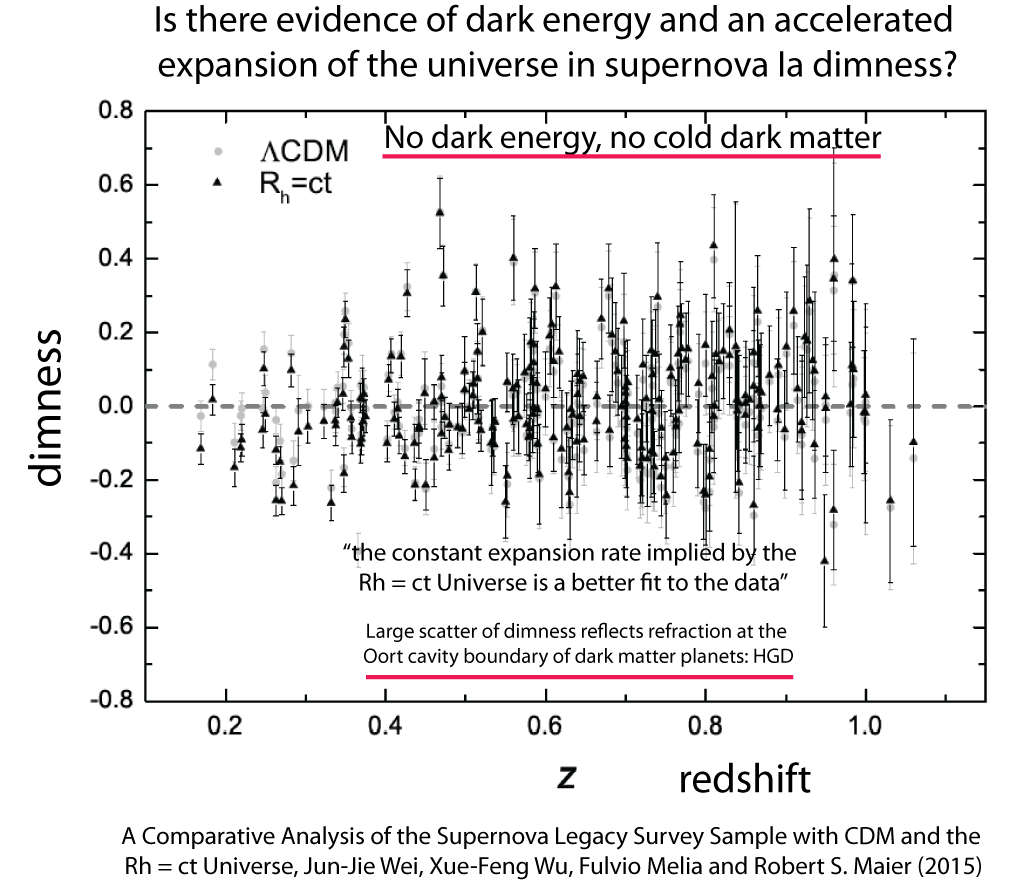
4. Traces of Earliest Stars That Enriched Cosmos Are Spied, New York Times article June 17, 2015, is loaded with misinformation from LCDMHC cosmology, and is commented by Carl H. Gibson to emphasize numerous unfortunate deviations from modern star formation theories of HGD cosmology, and the wide range of excellent new observations, including those of Sobral et al. (2015). The earliest stars are not massive, and do not reionize the universe after the plasma to gas transition at 300,000 years. The earliest stars are small, not large, and appear promptly (within 30,000 years) at 330,000 years after the cosmological big bang event near the cores of plasma epoch protogalaxies. The authors are nearly correct that this is the first detection Population III stars, but the stars are small, not large, and formed by mergers of dark matter planets that are nearly uncontaminated by large quantities of "metals". The authors are quite correct that their evidence of the early emergence of carbon, oxygen, nitrogen etc. signify the early emergence of life following the cometary panspermia scenario pioneered by Fred Hoyle and N. Chandra Wickramasinghe, which is strongly supported by HGD cosmology but not LCDMHC cosmology. HGD cosmology gives life and water oceans at only 2 million years, with plenty of nutrients from the early stars. LCDMHC can't make a star for 300 million years, let alone planets, water oceans and life.
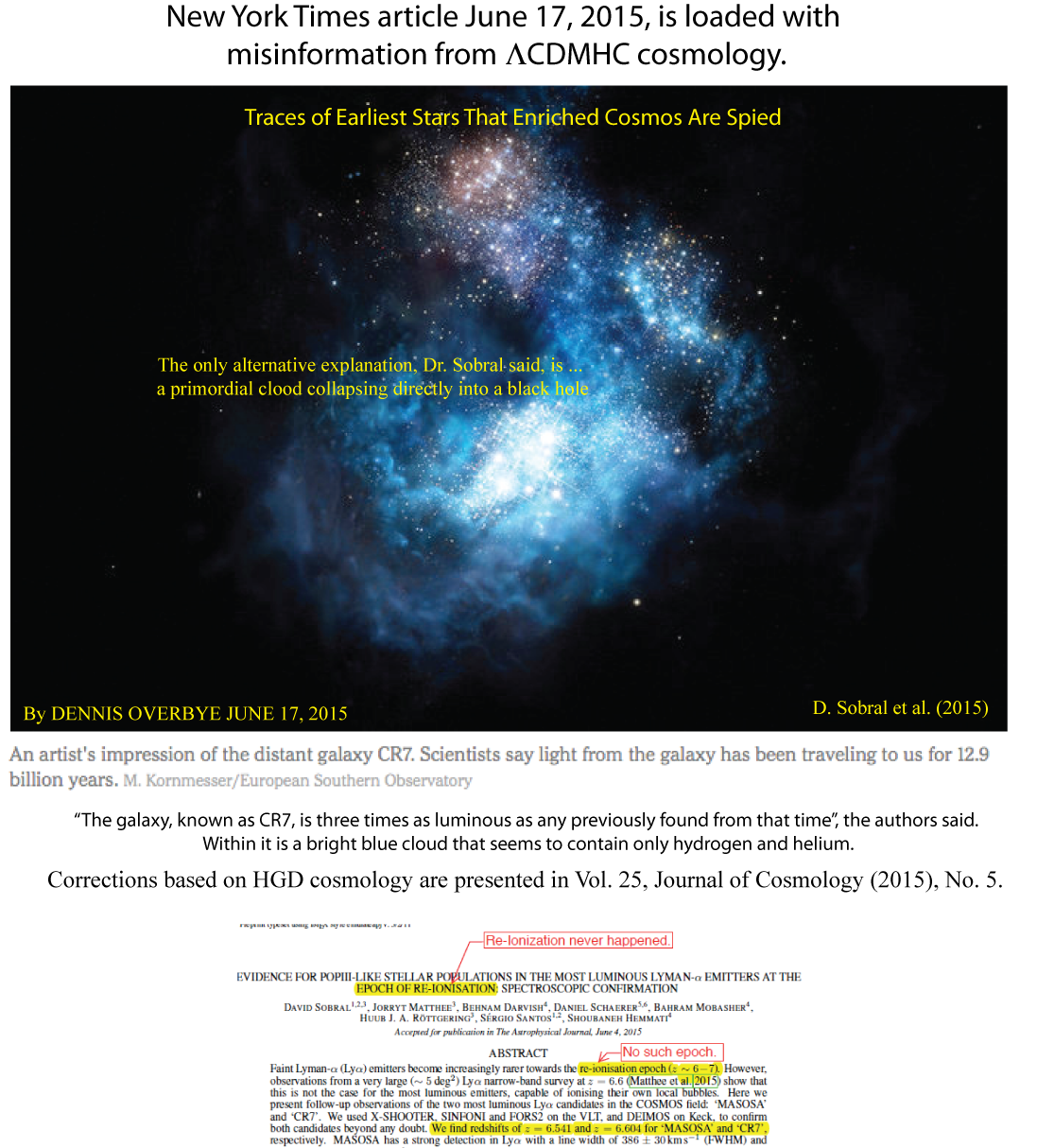
Figure JC2015.25.5.1 (CHG). The blue cloud in the figure is wrongly identified as massive Population III stars that reionize the gas formed at the plasma to gas transition. From HGD cosmology, massive stars never happened, and neither did reionization. There never was a reionization epoch. The gas fragmented into PGC clumps of a trillion earth-mass dark matter planets at the 10^13 second transition from plasma to gas (Gibson and Schild 1996). The speculation that the cloud may indicate the formation of a black hole is without foundation since black holes do not exist, only MECOs. pp 13140-13157.
5. Observational Evidence for a Dark Side to NGC 5128's Globular Cluster System, Matthew A. Taylor, et al. (2015) commented by Carl H. Gibson. pp 13159-13180. The observations are badly marred by misinterpretations of the excellent VLT data based on LCDMHC cosmology rather than HGD cosmology.
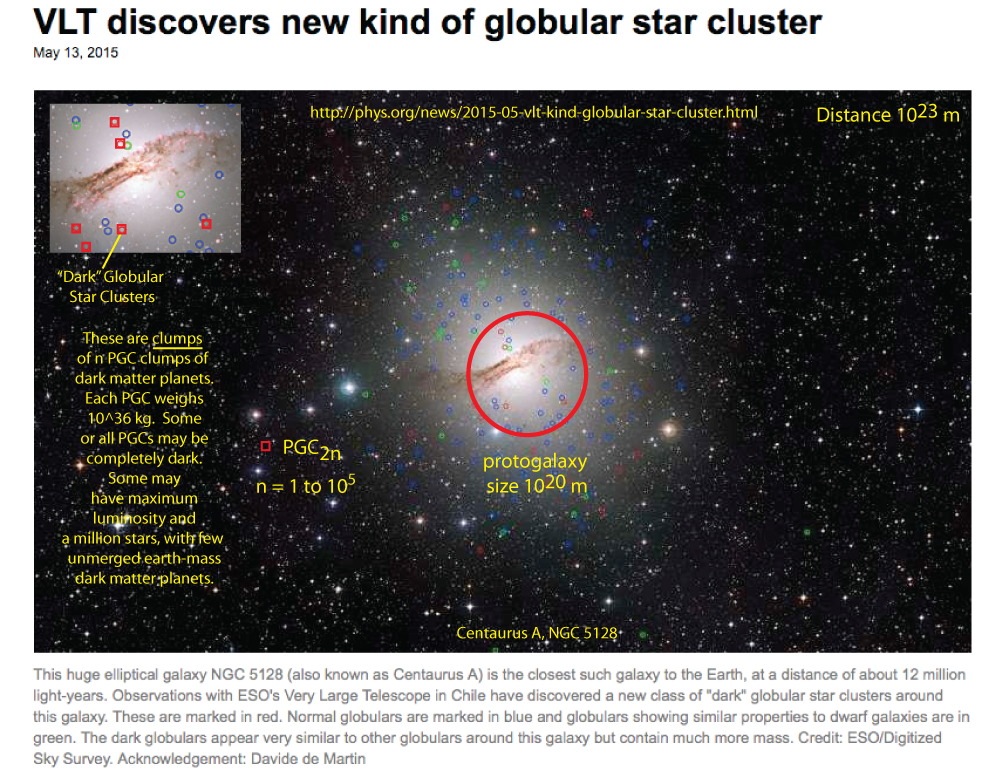
Figure JC2015.25.5.1 (CHG). The dark and massive globular star clusters identified by Taylor et al. (2015) are identified using HGD cosmology as clumps of PGCs fragmented from the central protogalaxy core of NGC 5128 when the dark matter planets freeze and diffuse into the outer halo. These objects are shown as red squares in the detail, upper left, and are termed PGC_2n suggesting most are formed by binary mergers of PGC_2n clumps with the same index n. They are not a "new kind of globular star cluster". They are clumps of protoglobularstarcluster PGCs with various fractions of their original dark matter planets merged to form larger planets and eventually stars. All PGCs retain the same total mass of about 10^36 kg and the same density ~ 10^-17 kg m^-3. This was the baryonic density at 30,000 years. All protogalaxies have about a million PGCs or 10^42 kg. The largest clumps of PGCs diffused from the center of the Milky Way were the Magellanic Clouds, each with about 10^5 PGCs or 10^41 kg, and each with size 10^20 m, the size of protogalaxies, shown as the red circle in the figure. pp 13181-13183.
Note the close analogy between PGCs and these PGC_2n clumps of PGCs. Both maintain states of metastable equilibrium that persist for billions of years. The dark matter planets in a PGC have retained the baryonic density of these objects (~10^-17 kg m^-3) as a fossil of the time of first fragmentation of the plasma only 30,000 years after the big bang. The planets form larger planets (P_2n) and all the stars by binary collisions within these stable PGC clumps of a trillion planets. Similarly, the protogalaxy clumps of these PGC clumps have preserved their ~ 10^20 m size in a metastable equilibrium at the core of all galaxies since the time of plasma to gas transition at 300,000 years by binary collisions and mergers of the protogalaxy PGCs. These processes cannot be described by LCDMHC cosmology which is collisionless. HGD cosmology and collisional fluid mechanics are required to adequately characterize the physical processes.
6. Galaxies at redshifts 5 to 6 with systematically low dust content and high [C II] emission, P. L. Capak et al. (2015), Nature article about ALMA observations, commented by Carl H. Gibson. pp 13185-13210. Interpretations of the observations are highly questionable because star formation rates and star masses are based on LCDMHC modeling. Some evidence of chain clusters is found in these nine early galaxies, using the excellent resolution of ALMA. The high CII emission at these large redshifts reflects the high density of the universe rather than low dust content. Viscous stresses have kept the protogalaxies produced during the plasma epoch together, resisting the expansion of the universe. Evidence of fossil turbulence chain clusters of galaxies from the plasma epoch can be seen.
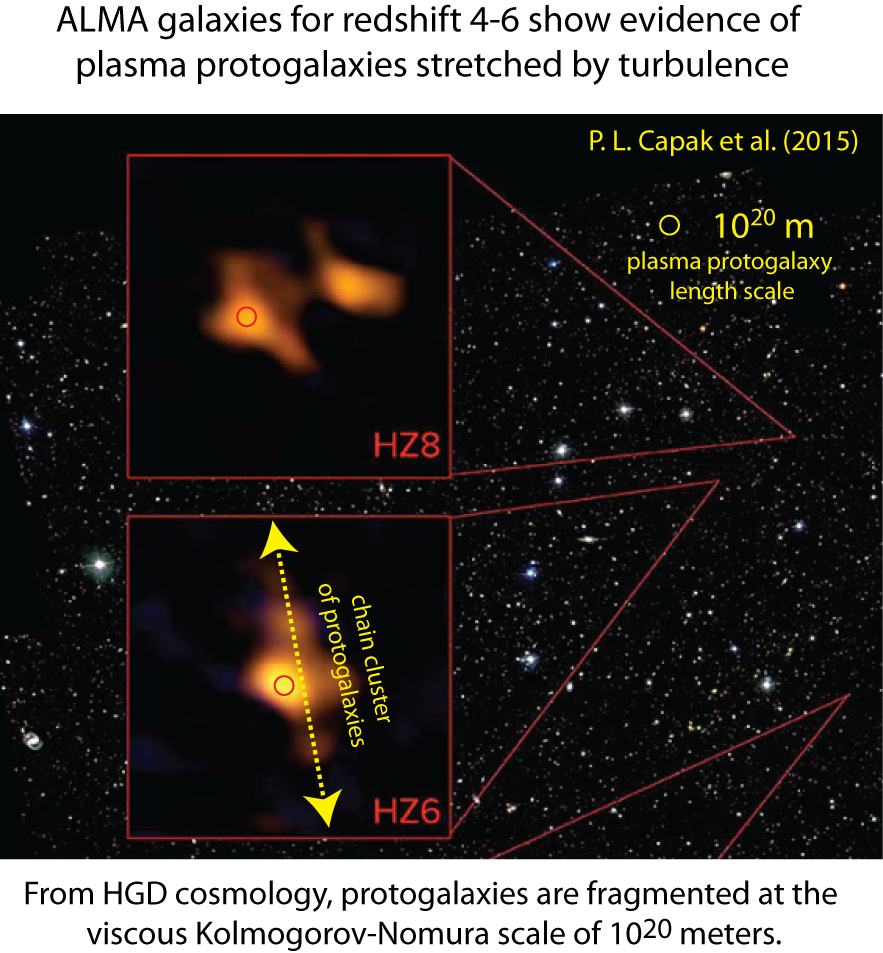
Figure JC2015.25.6.1 (CHG). ALMA observations at high redshifts (z = 4-7) have <arcsec resolution, showing the morphology of galaxies produced by viscous-gravitational-turbulence fragmentation during the plasma epoch. These galaxies are a billion years old and too dim to be seen except in the ultraviolet frequencies made available by the ALMA long baseline radio telescope. The size matches the protogalaxy scale of turbulent fragmentation predicted by HGD cosmology; that is, the viscous Kolmogorov-Nomura scale 10^20 meters. Viscous stresses resist fragmentation of the protogalaxies to form a linear chain galaxy cluster by stretching of weak plasma turbulence along the vortex line, as postulated by the dashed double arrow for galaxy HZ6. pp 13211-13212.
Figure JC2015.25.6.2 (CHG). K. Onishi et al. (2015) study galaxy NGC 1097 at a distance of 4.4x10^23 meters, much closer than the Capak et al. (2015) galaxies. A brief report of Onishi (2015) and a sample calculation of the expected protogalaxy size is discussed in an Editorial Commentary by Carl H. Gibson. The high ALMA resolution and spectral sensitivity to molecules hydrogen cyanide and formylium permit resolution of spin axes of the central core and its starburst ring at 40% of the protogalaxy diameter 10^20 m (shown by the red circle). The alignment of spin axes for the galaxy, central core, and starburst ring demonstrate that all are connected by the turbulent collisional fluid mechanics of HGD cosmology, where protogalaxy fragmentation and stretching by vortex lines is triggered by turbulence early in the plasma epoch (30,000 years) on the boundaries of expanding supersupervoids (>10^25 m diameter). Comparison is made with the high redshift galaxies of Capak et al. (2015) in the lower right corner of the figure. pp 13213-13215.
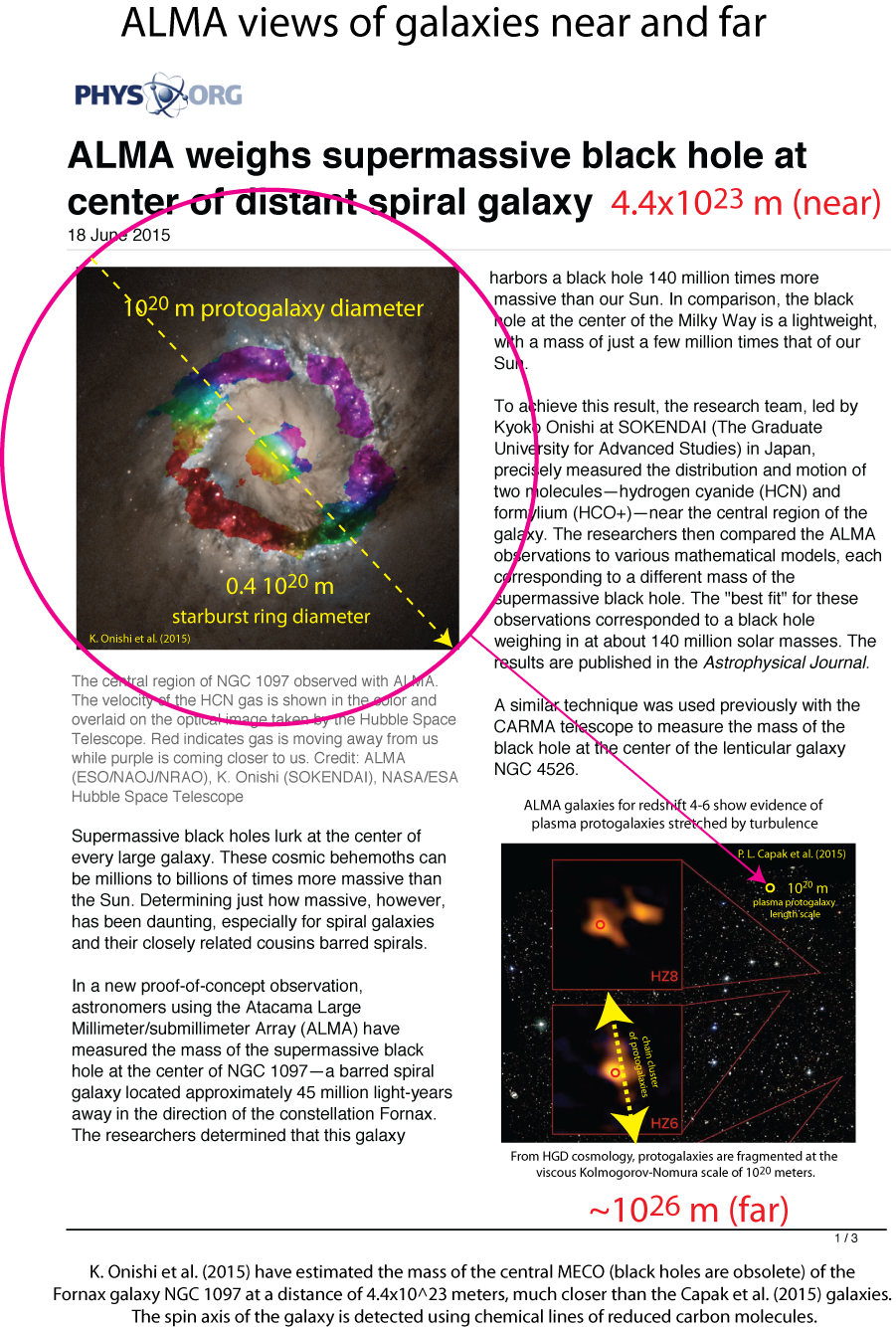
7. Protogalaxies not stretched by turbulence may not develop many stars, Carl H. Gibson commentary on P. van Dokkum et al. (2015) SPECTROSCOPIC CONFIRMATION OF THE EXISTENCE OF LARGE, DIFFUSE GALAXIES IN THE COMA CLUSTER. pp 13216-13224.
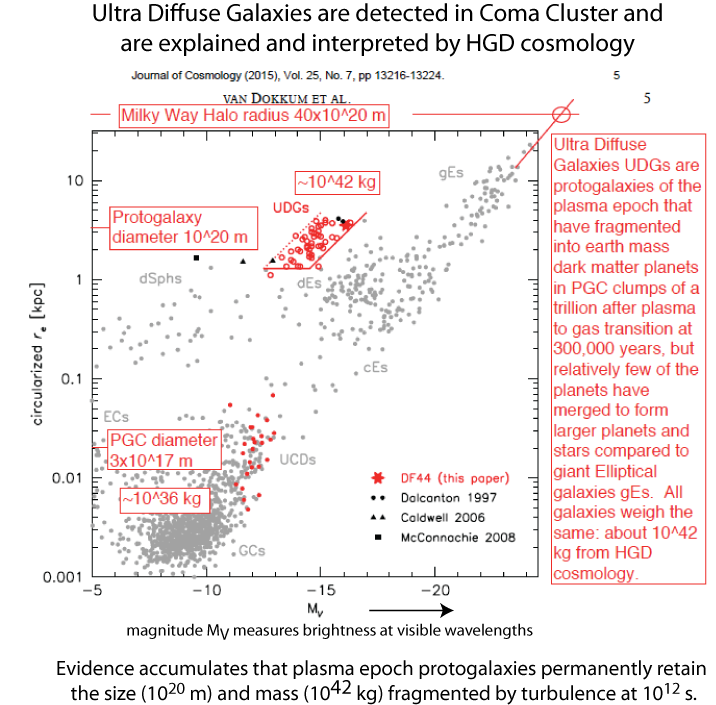
Figure JC2015.25.7.1 (CHG). P. Dokkum et al. (2015) Fig. 4 (commentary) show that many dim UDF galaxies exist in the COMA cluster, with ~ -18 smaller visual brightness compared to giant Elliptical galaxies. pp 13225-13227.
8. Evidence of clumping by collisional Ultra Diffuse Galaxies, Commentary by Carl H. Gibson on preprint APPROXIMATELY A THOUSAND ULTRA DIFFUSE GALAXIES IN THE COMA CLUSTER (2015 ApJL), Jin Koda, Masafumi Yagi, Hitomi Yamanoi, Yutaka Komiyama. pp 13228-13236.
9. Are baryons oscillating in the CMB?, Commentary by Carl H. Gibson on ApJ paper PROPERTIES OF WEAK LENSING CLUSTERS DETECTED ON HYPER SUPRIME-CAMís 2.3 deg^2 FIELD, Satoshi Miyazaki et al. (2015), pp 13237-13251. The interpretation that the "sonic peak" observed in CMB temperature anisotropy spectra represents sonic baryon oscillations in Cold Dark Matter (CDM) halos is questioned by HGD cosmology and repudiated by all observations.
10. Were the gas epoch PGCs and dark matter planets reionized?, Commentary by Carl H. Gibson on ApJ (2003) paper REIONIZATION OF HYDROGEN AND HELIUM BY EARLY STARS AND QUASARS, by J. Stuart B. Wyithe and Abraham Loeb. pp 13252-13268. The early stars that cause reionization are claimed to be massive stars by Wyithe and Loeb, but massive stars do not exist, and have never existed, according to HGD cosmology, as shown in the following figure.
Figure JC2016.25.10.1 (CHG). Hertzsprung Russell diagram modified according to Gibson and Schild HGD cosmology (1996), where all stars
are formed by mergers of Earth mass dark matter planets (M ~ 10^24 kg) within PGC clumps of a trillion (M ~ 10^36 kg) until they explode by supernova. Stars formed this way are limited in mass to that
of their supernova precursors. For supernova class I, this is the Chandrasekhar limit of ~ 1.4 solar mass for white dwarf carbon stars (density ~10^10 kg m^-3). For supernova class II, this is the mass
of a pulsar ~ 1.3 solar mass for iron-nickel core stars (density ~10^17 kg m^-3) that are super-bright because their rate of dark matter planet
feeding greatly exceeds the nonturbulent planet accretion rate for carbon stars. Pulsars are rapidly spinning neutron stars. PGC binaries have been misinterpreted as massive star binaries
(see paper No. 5 in this Volume 25). Massive stars are a myth of LCDMHC cosmology. They never happened, and are not needed to explain the
HGD modified HR diagram.

Dark matter planets serve as fluid particles for a dense collisional fluid that forms O, B, and A stars. The fluid becomes turbulent and solar mass stars can be seen as bright "Christmas tree light" strings along the turbulent vortex lines leading to the OBA stars.
11. EVIDENCE OF ALIEN LIFE DOWNGRADED OR DENIED, N. Chandra Wickramasinghe and Gensuke Tokoro pp 13269-13272.
12. INTERNATIONAL CONFERENCE TO MARK THE CENTENARY OF EINSTEIN’S THEORY OF GENERAL RELATIVITY AND THE BIRTH OF SIR FRED HOYLE, report by N. Chandra Wickramasinghe, pp 13273-13275.
13. Weak lensing shows the mass of galaxies, Commentary by Carl H. Gibson on The masses of satellites in GAMA galaxy groups from 100 square degrees of KiDS weak lensing data, by Crist´obal Sif´ et al. (2015), pp 13276-13290.
14. Extraterrestrial Life is an Observational Fact, not a "Theory", Commentary by Carl H. Gibson on Evidence to Clinch the Theory of Extraterrestrial Life, N. Chandra,Wickramasinghe, pp 13291-13294.
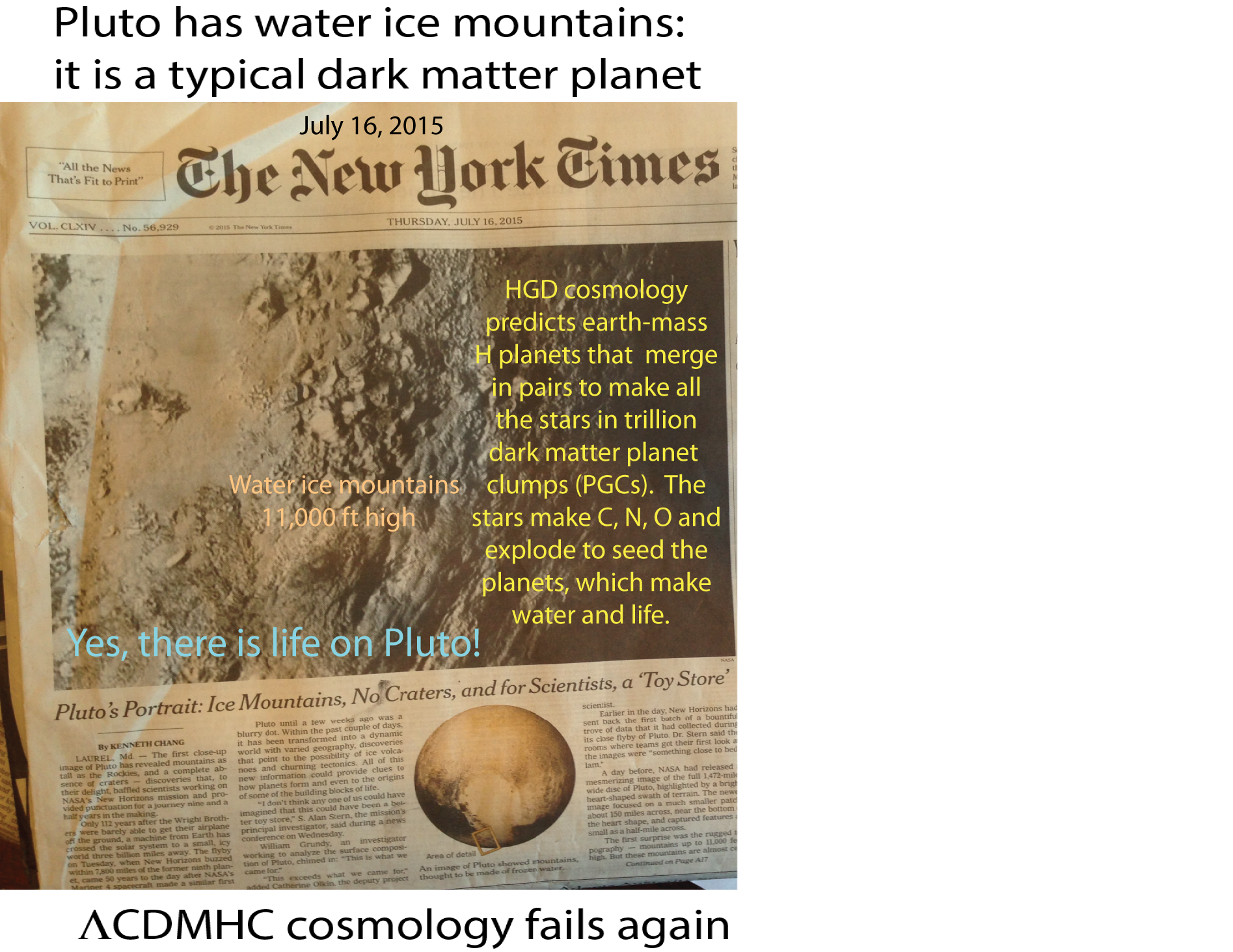
Figure JC2015.25.14.1 (CHG). July 16, 2015, New Horizons spacecraft passes near Pluto. The large mountains observed can only be water ice, strongly supporting HGD cosmology as the source of Pluto, and its extraterrestrial water oceans and life, rather than LCDMHC cosmology. Methane ice is observed in the "north" polar region of Pluto, further clinching this new evidence of extraterrestrial life, pp 13295-13296. An abstract titled Pluto-like planets dominate the dark matter of all galaxies has been submitted by Carl H. Gibson to the UCLA conference February 17-19, 2016, Sources and Detection of Dark Matter and Dark Energy in the Universe, pp 13297-13298.
15.Debris from MH370 crash arrives on Reunion Island, Carl H. Gibson Editorial commentary, pp 13300-13308.
This paper has been moved to the Catastrophic Equatorial Icing-dedicated Volume 28
16. New Directions in Modern Cosmology, conference in Leiden, Netherlands, 2010, Volume 15, Journal of Cosmology (2011), Proceedings Commented by Carl H. Gibson, pp 13320-13659. Webarchive of Volume 15.
17. "NASA astrobiology roadmap is misleading", Commentary by Carl H. Gibson, pp 13660-13680, on a damaging NASA sponsored document affecting the search for extraterrestrial life. See the program for the seventeenth San Diego SPIE conference on astrobiology. Many of the presentations reflect misinformation from such NASA roadmaps.
18. The standard model for Life's origin on Earth, Steven Benner. pp 13682-13728. Note that Steven Benner is one of the authors of the NASA roadmap for astrobiology in JoC.25.17.
19. The standard model for Life's origin on Earth is inadequate, Comments by Carl H. Gibson. pp 13730-13776.
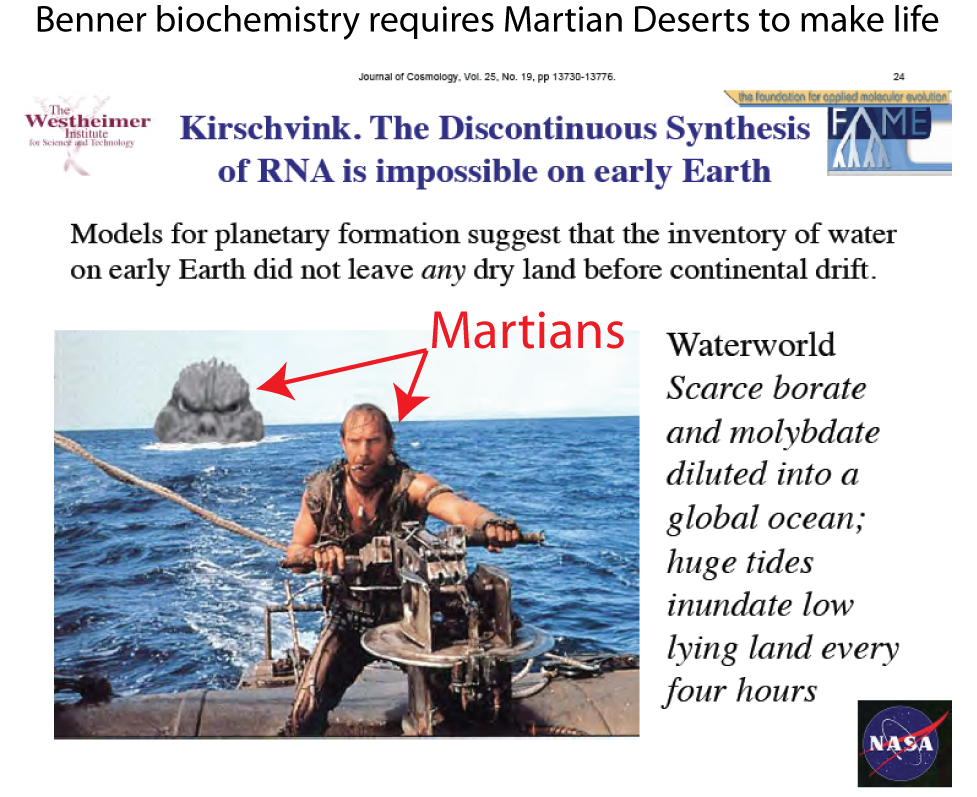
Figure JC2015.19.1 (Carl H. Gibson) "Are we all Martians?". Professor Benner shows that life could not possibly evolve without the biochemical assistance of desert conditions, which might be provided by Mars that is known to supply meteorites to Earth. pp 13777-13778. The early Earth was much too wet. Benner shows that synthesis of RNA is impossible on Earth alone for this reason, and suggests at least one other planet, like Mars with its early desert conditions, might be a collaborating host in this critical evolutionary phase of terrestrial life formation, making all of us Martians, as shown. So we see that the number of collaborating planets in the soup is now between two and 10^80 Earth mass hosts to make life. HGD cosmology offers the much larger number, not counting moons and fragments, that might support life. The primordial soup of interacting planets at 330,000 years was hot, cooling from ~10^4 K, often wet and often dry, with the high density and pressures needed to make rapidly evolving DNA-RNA life forms at two million to eight millions years after the cosmological big bang (defining the biological big bang) quite inevitable. It has been an observational fact since Schild (1996) that the dark matter of all galaxies is < Earth mass planets, > thirty million such planets per star.
20. LYMAN-ALPHA EMISSION FROM A LUMINOUS z=8.68 GALAXY: IMPLICATIONS FOR GALAXIES AS TRACERS OF COSMIC REIONIZATION, Adi Zitrin et al., Comments by Carl H. Gibson, pp 13779-13785.
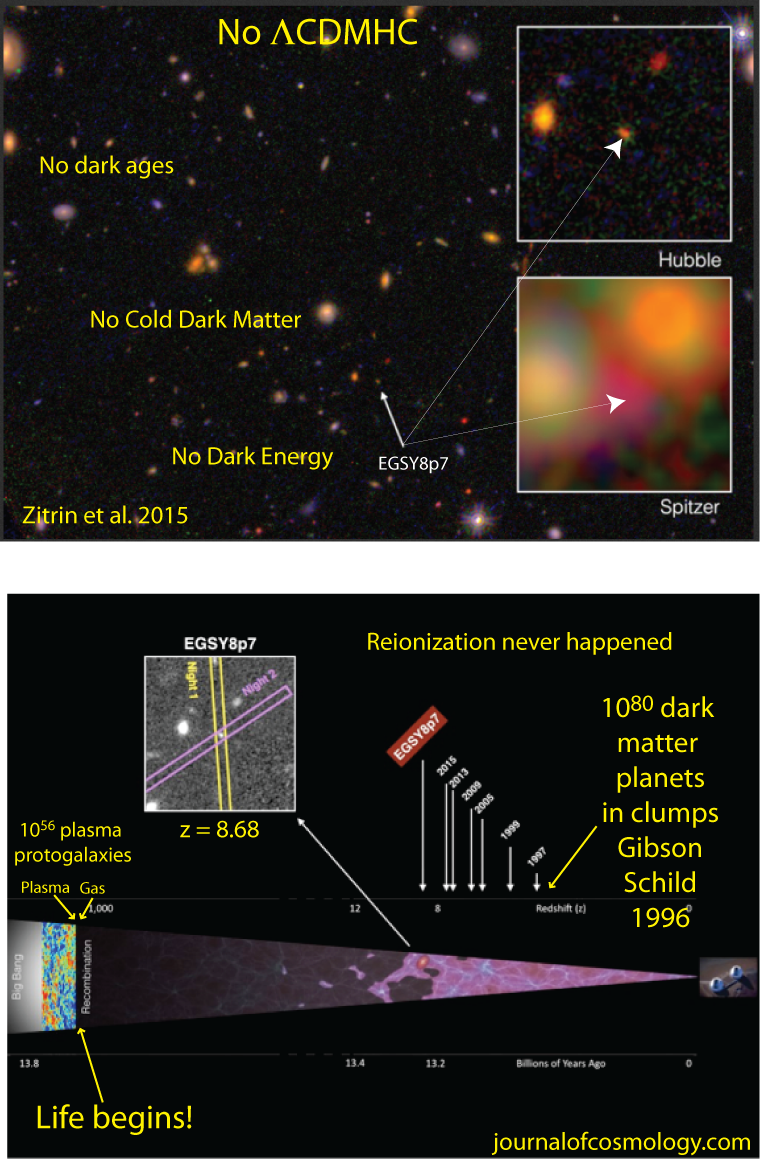
Figure JC2015.20.1 (Carl H. Gibson) "Where is the reionization?". The answer is "nowhere" because reionization never happened. There were never any super massive stars, as imagined for this purpose. All stars are made from ~10^80 merging 10^24 kg dark matter hydrogen planets, which appear in clumps of a trillion at the plasma to gas transition, within a free fall time of 10^12 seconds: a time that reflects the plasma density when the 10^56 protogalaxies from the big bang began to fragment. When the larger planets formed from smaller binary planet mergers (eg Pluto-Charon) approach stellar mass they heat up and burn trace deuterium, tritium and helium^3 as brown dwarfs, and then explode as supernovae I and II events when the iron-nickel stars and carbon-oxygen stars acrete enough planets to exceed 30% to 44% of solar mass, respectively. This distant galaxy proves there were no dark ages, cold dark matter halos, dark energy, or many of the other LCDMHC speculations required when the collisionless Boltzmann equation is assumed rather than HGD collisional fluid mechanics.
21. Hydro-gravitational-dynamics cosmology is crucial to astrobiology and the biological big bang at two million years, Carl H. Gibson, Preprint of SPIE 2015 paper, pp 13378-13402.
22. Pluto images clinch the existence of water, methane, and life on this typical dark matter planet, Carl H. Gibson, Preprint of SPIE 2015 paper, pp 13404-13419.
23. The cosmic web and microwave background fossilize the first turbulent combustion, Carl H. Gibson, Preprint of SPIE 2015 paper, pp 13421-13431.
24. Is there strong evidence against the big bang?, Carl H. Gibson comments on Dolgov preprint, pp 13433-13440.
25. Age of the universe and more, Carl H. Gibson comments on Evgeny Novikov preprint, pp 13442-13452.
26. Catastrophic Equatorial Icing May be Crashing Airplanes, Carl H. Gibson
This paper has been moved to the Catastrophic Equatorial Icing-dedicated Volume 28
27. First scientific paper (in Science) about Pluto-Charon images shows water-ice mountains and slush oceans of frozen methane, signifying lots of life. Commented by Carl H. Gibson. pp 13496-13504.
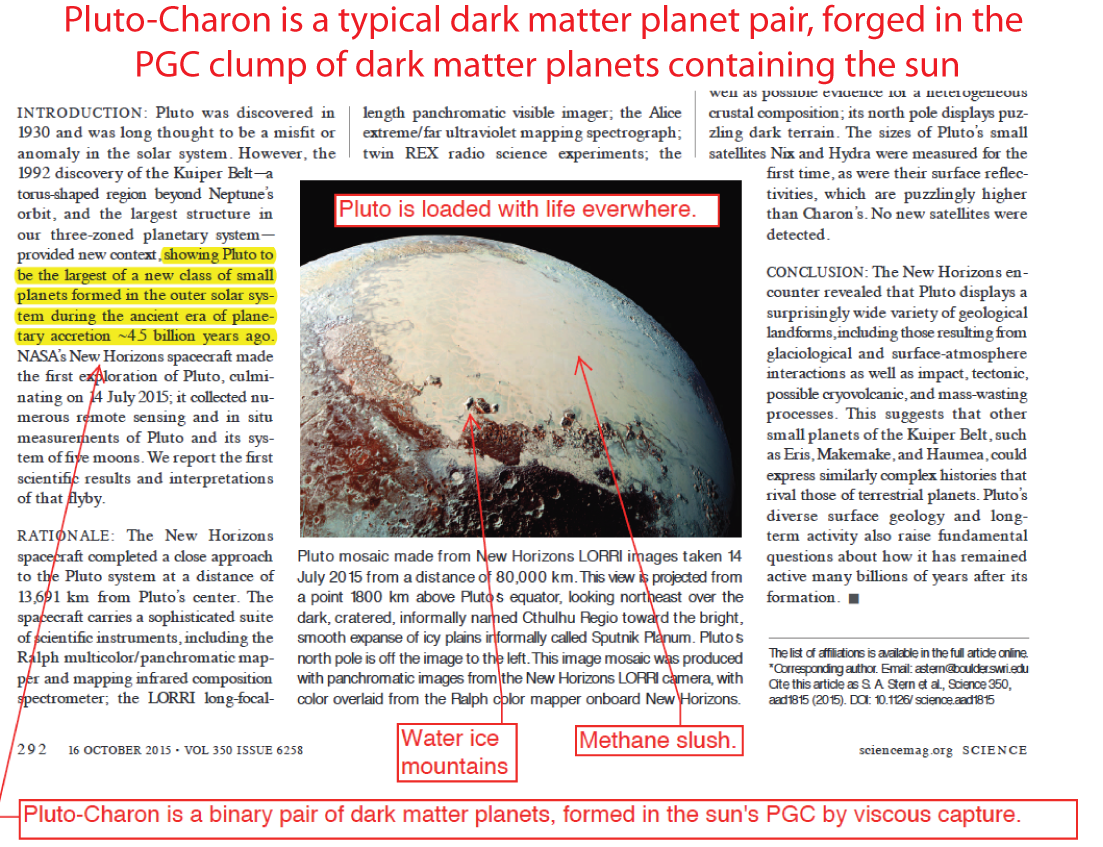
Figure JC2015.27.1 (Carl H. Gibson). Color images with high resolution reveal Pluto-Charon to be an agent of Hoyle-Wickramasinghe cometary panspermia, transporting water and life from the protoglobularstarcluster PGC clump of dark matter planets of the sun where stars are formed by dark matter planet mergers.
28. Do micro brown dwarf detections explain the galactic dark matter? Clearly yes, from all observations of these dark matter planets, Commented by Carl H. Gibson. pp 13505-13528.
29. Baryon Oscillations Do Not Exist, Commentary by Carl H. Gibson on a recent preprint, pp 13529-13595.
30. Life began much earlier than usually assumed, Commentary by Carl H. Gibson on a recent paper, pp 13596-13597.
31. Gravity or turbulence?, Aina Palau1 et al. 2015. Commentary by Carl H. Gibson on a recent preprint, pp 13598-13612.
32. Cosmic Dawn (the first stars) begins at 0.3 Myr, not 200 Myr. Commentary by Carl H. Gibson on a recent Nature article, pp 13613-13625.
33. Earth-like exoplanet detected merging with red dwarf star. Commentary by Carl H. Gibson on a recent Nature article, pp 13626-13636.
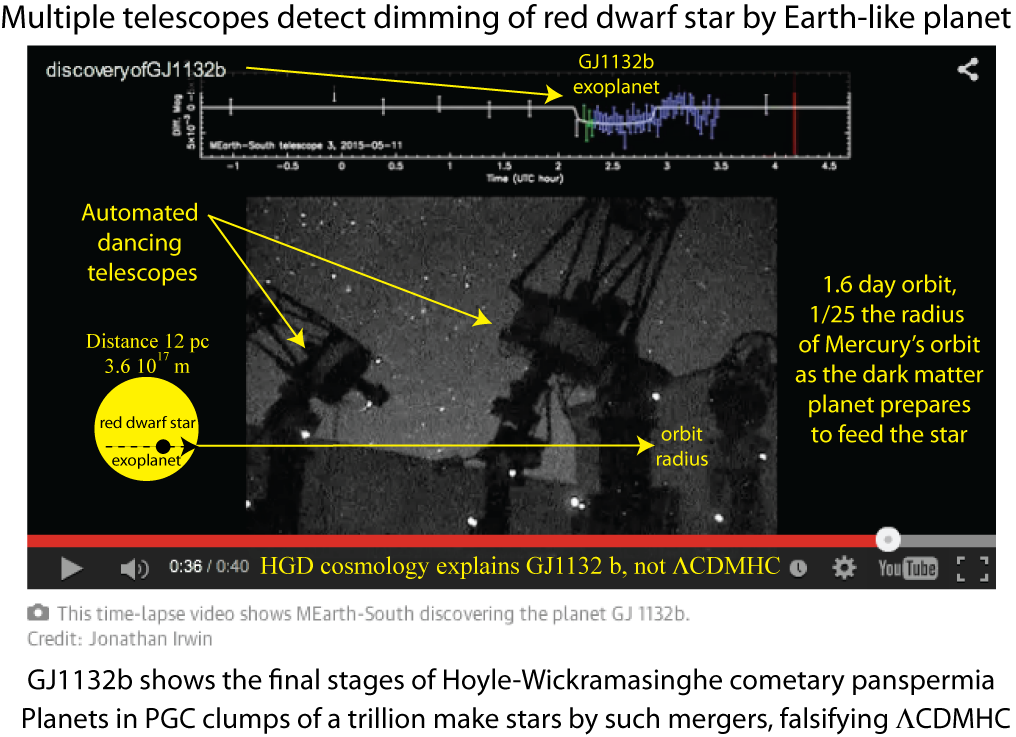
Figure JC2015.33.1 (Carl H. Gibson). Final stages of an exoplanet merger, feeding a small nearby star.
34. An ultra-faint dwarf galaxy is explained (Carl H. Gibson). pp 13637-13643.
35. Should we believe Phil Plait about diatoms arriving on Earth by Hoyle/Wickramasinghe cometary panspermia? (Carl H. Gibson). pp 13644-13650. Phil Plait (author of the "Bad Astronomer" blog) argues in 2013 that diatoms did not arrive on Earth in meteors by slandering Professor Wickramasinghe and the Journal of Cosmology. Editor-in-Chief Rudolph E. Schild suggests a better name for the PP commercial blog is "Bad Scientist" in his Editorial Commentary, JofC,Volume 22. From this 2013 evidence, Cometary Panspermia of Hoyle/Wickramasinghe should be considered an Observational Fact, as claimed at that time (CHG).
36. Tritonia replaces Pluto-Charon as the ninth solar system planet, Carl H. Gibson, UCSD, pp 13651-13663. Peer review by Professor Chandra Wickramasinghe. Press Release. Revised Press Release (with figures).

37. Turbulence at the Equator causes maximum mixing and maximum confusion. Commentary on "Mixing With Lattitude", Garrett, Nature (2003), Carl H. Gibson, pp 13664-13666.
This paper has been moved to the Catastrophic Equatorial Icing-dedicated Volume 28
38. Turbulence measurements at the Equator are vastly undersampled. Commentary on "Reduced mixing from the breaking of internal waves in equatorial waters", Gregg et al., Nature (2003), Carl H. Gibson, pp 13667-13670.
This paper has been moved to the Catastrophic Equatorial Icing-dedicated Volume 28
39. Dark matter planet "dust" in distant galaxies, Commentary on Fujimoto et al 2016 paper by Carl H. Gibson, pp 13673-13703.
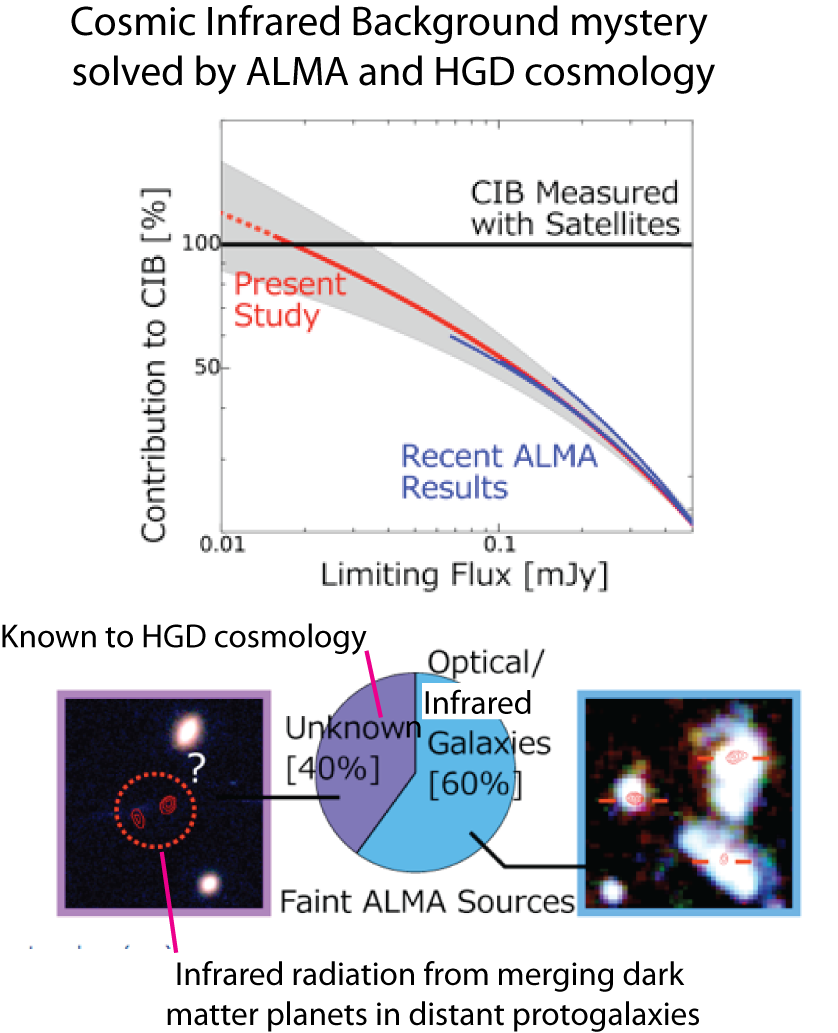
Figure JC2016.39.1 shows images from the Fujimoto et al. 2016 ALMA press release, solving the Cosmic Infrared Background (CIB) mystery about the missing 40% sources. According to HGD cosmology, distant protogalaxies consist of PGC clumps of dark matter planets that merge to form the first stars, soon after the plasma to gas transition at 0.3 Myr, not at 300 Myr according to the standard LCDMHC model. The mergers can emit powerful amounts of infrared radiation to produce ultra luminous infrared galaxies (ULIGs) or weak amounts that fail to trigger detectable stars and supernovae, resolving the mystery (question mark in lower left image) of the unknown 40 % CIB radiation by rejecting standard LCDMHC modelling, p 13704.
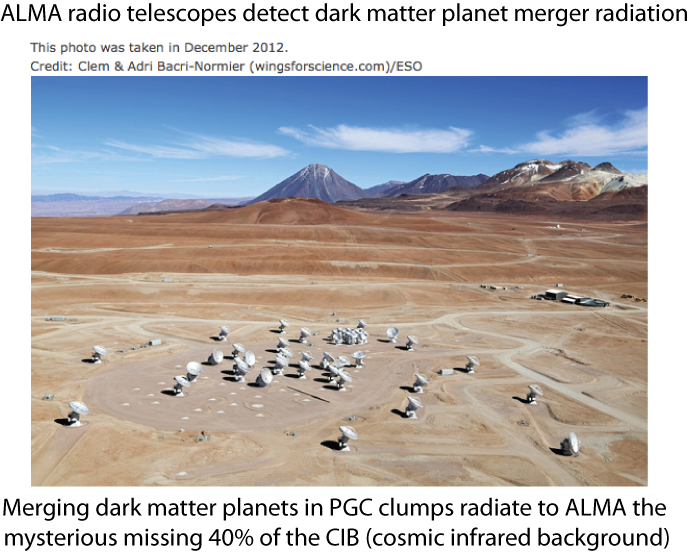
Figure JC2016.39.2 view of ALMA on the Atacama high plains of Chile, p 13705.
40. Commentary on "Where are Most of the Globular Star Clusters in Today's Universe?", W. H. Harris 2016, by Carl H. Gibson, Titled "Protoglobularstarcluster dark matter planet clumps persist since formation at ~ 10^13 s". Such questions are rendered obsolete by HGD cosmology, where all galaxies weigh the same (~ 10^43 kg), dominated by PGC dark matter planet clumps (~ 10^36 kg) of a trillion dark matter planets (~ 10^24 kg), pp 13706-13711.
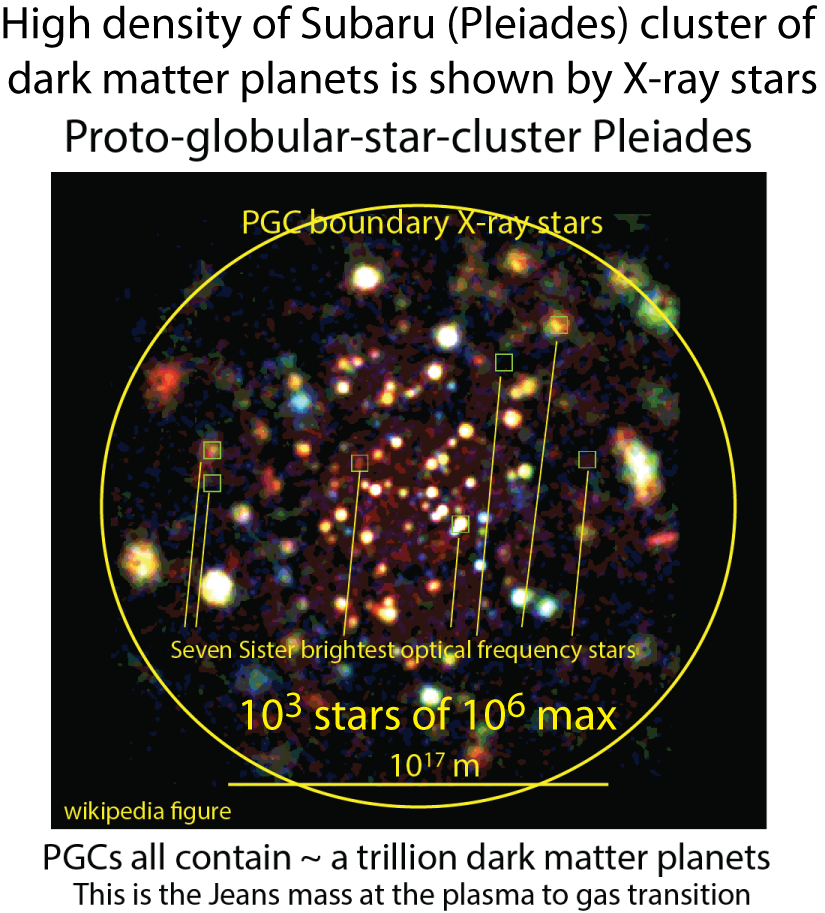
Figure JC2016.40.1 shows the nearby Subaru (Pleiades) PGC (protoglobularstarcluster) in X-ray stars. Only ~ 10^3 out of the possible maximum of ~10^6 stars have formed (0.1%), showing most of the dark matter planets of the PGC are frozen ~ 10^24 kg hydrogen in these Jeans mass clumps of a trillion, for a total ~ 10^36 kg PGC mass. The large density of the PGC is ~10^-15 kg/m^3, matching the baryonic density at 10^12 seconds when protogalaxies fragmented according to the HGD cosmology of Gibson (1996) and Schild (1996), contrary to LCDHC cosmology where stars form from gas and dust rather than dark matter planets. All observed PGCs and GCs have this density, which is ~10^6 larger than that of a galaxy (~10^-21 kg/m^3). Note that the Milky Way has only two hundred GCs, but some galaxies have thousands, depending on the fraction of the 10^7 PGCs/galaxy that have formed all their stars by dark matter planet mergers, p 13712. The large PGC density is a fossil of the second turbulence event, p 13712.
41. Commentary on Hezaveh et al. 2016 titled "Best to forget LCDMHC", by Carl H. Gibson, pp 13713-13731.
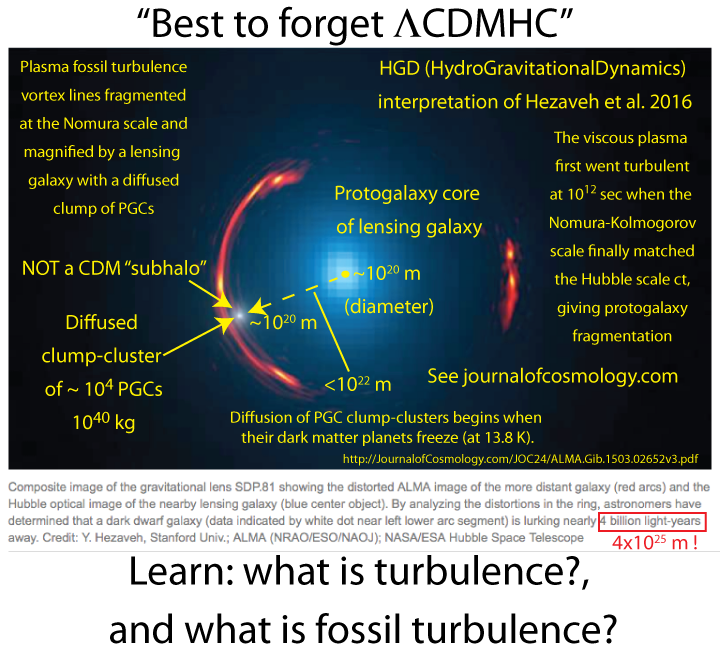
Figure JC2016.41.1 provides the HGD interpretation of the Hezaveh et al. 2016 ALMA observations of the Einstein ring produced by the HST foreground galaxy gravitationally lensing a distant fossil turbulence string of protogalaxies from the plasma epoch fragmented along turbulent vortex lines at a time t only 30,000 years (10^12 s) after the big bang. It is recommended that the authors should forget the obsolete LCDMHC cosmology in favor of HGD (Gibson 1996, Schild 1996), where it is shown that turbulence always forms at a universal critical Reynolds number and cascades from small scales to large, fossilizing when the defining inertial vortex forces are damped by other forces. Fossil turbulence is any hydrophysical field produced by turbulence that persists after the fluid is no longer turbulent at the scale of the perturbation. The spin, rate-of-strain, and density at 10^12 s are all fossils of the second turbulence event after the initial big bang turbulent combustion (quenched by gluon viscosity at ~ 10^-27 seconds) event, which was the first turbulence. The authors have NOT discovered a subhalo CDM condensate, but a diffused clump of ~ 10^4 PGCs similar to the Magellanic cloud galaxies of the Milky Way that diffused from our protogalaxy when the dark matter planets began to freeze, p 13732. Further HGD interpretation of ALMA information is given by the reference at bottom right of the figure. The importance of large time periods in biological processes is recognized, even in cartoons.
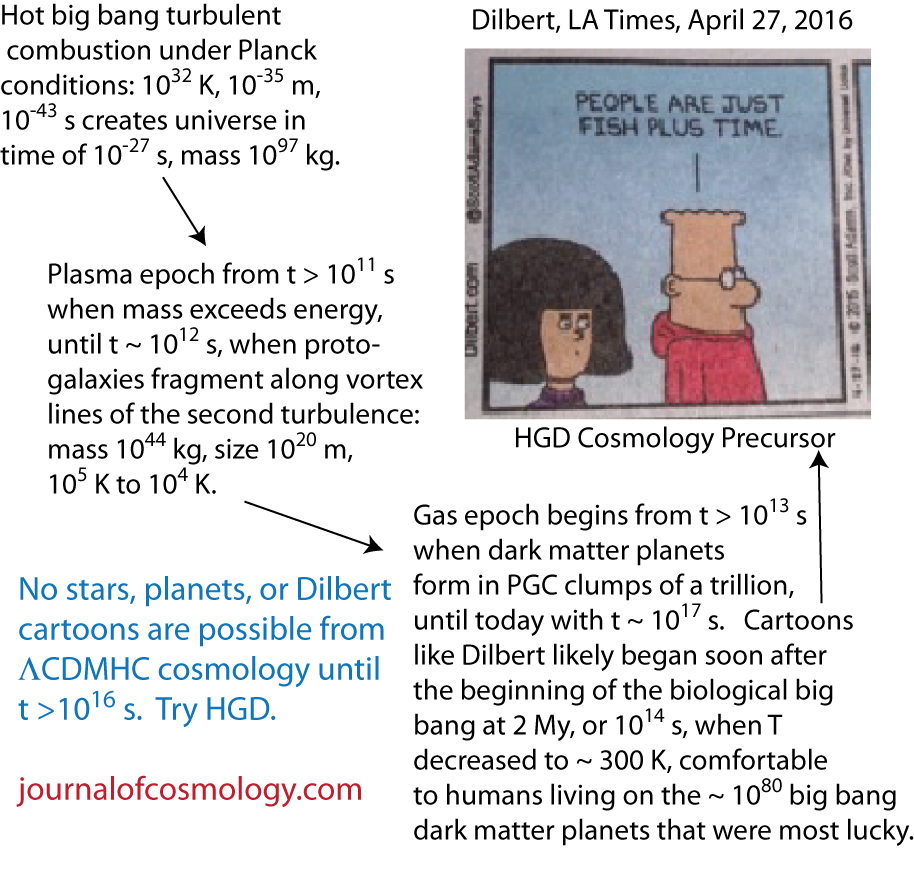
Figure JC2016.41.2 extends the time for fish to evolve to people (~ Myr) to the time for the big bang to evolve to cartoonists (~ 13.7 Byr). p 13733.
42. Commentary on T. Nieuwenhuizen "Neutrino mass and signature from the dark matter in A1689" by Carl H. Gibson, titled "Is the nonbaryonic dark matter Theo-neutrinos?", pp 13735-13742.
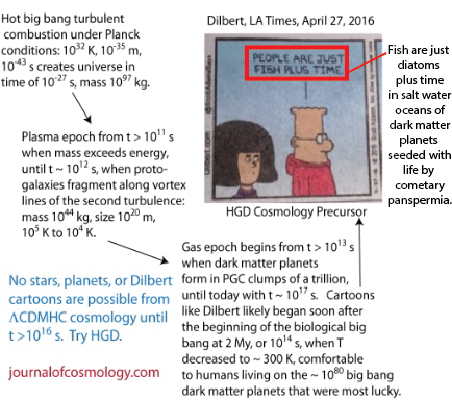
Figure JC2016.42.1 modifies Dilbert cosmology to include the biological big bang and Hoyle-Wickramasinghe cometary panspermia. The primary difficulty with the Nieuwenhuizen manuscript is that it contains vestiges of the failed LCDMHC cosmology important to the mass-energy balances affecting BDM (dark matter planets) and NBDM (Theo neutrinos). References to turbulence fail to distinguish between New turbulence (based on the inertial vortex force) and Old turbulence (which can cascade from large scales to small). Fossil turbulence and BZTMA mixing are not mentioned, but are crucial. New turbulence always cascades from small scales to large, and always obeys the three universal similarity laws of Kolmogorov. Dilbert and HGD cosmologies are clinched by the Schild (1996) observations of "rogue planets", and by the many convincing observations of cometary transport of extraterrestrial life presented by Professor N. C. Wickramasinghe and his colleagues. The implication is the existence of lots of extraterrestrial people, not to mention cartoonists, p 13744.
43. "A Universe without Inflation (A model of Time)", Salim Yasmineh, pp 13746-13784.
Second Edition takes into account some aspects of HGD (collisional fluid mechanics) cosmology.
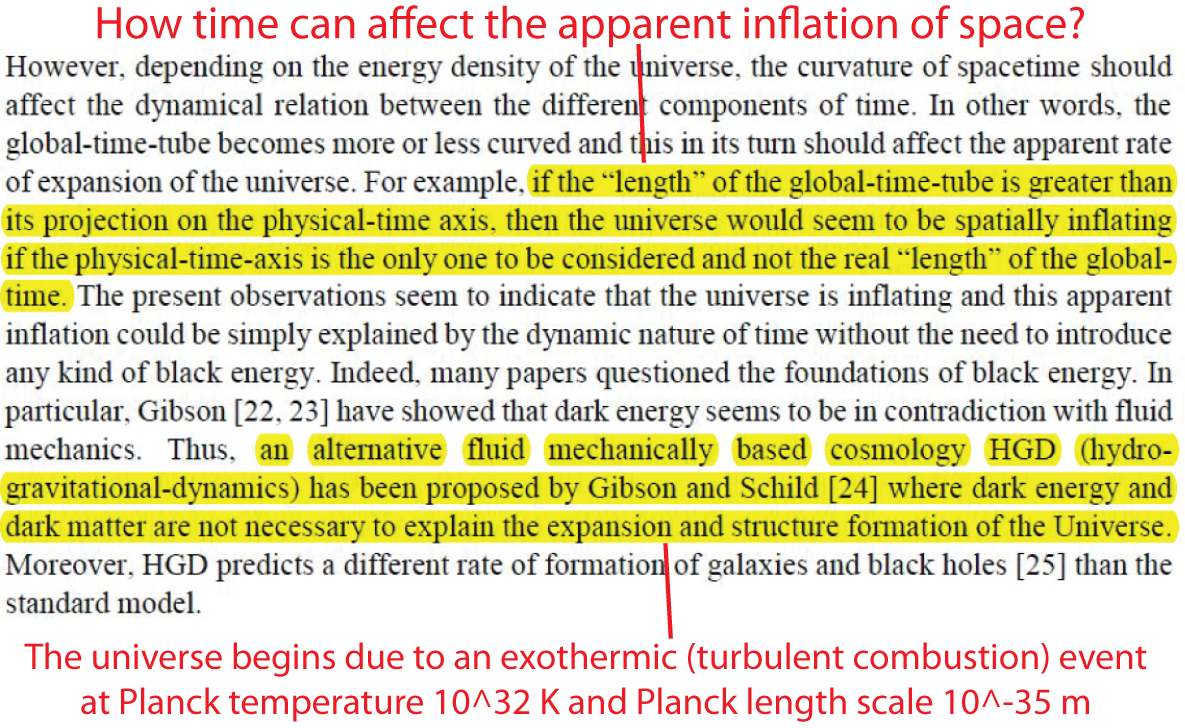
44. "Stars are formed by mergers of dark matter planets", Carl H. Gibson. Commentary on Tokuda et al. 2016," A detailed mass distribution of a high-density core in Taurus with ALMA", which nicely confirms HGD predictions of star formation from dark matter planets within protoglobularstarcluster (PGC) clumps of these planets, and does not support star formation from gas and dust. Figure 2 from Nieuwenhuizen, Schild and Gibson (2010) shows > Jupiter mass comets forming a star in the Helix planetary nebula, using the infrared telescope Spitzer. A thousand dark matter planets merge to form one Jupiter. A thousand Jupiters merge to form one star. Because the planets are frozen H and He, the Jupiters and central stars are spinning binaries, masked in the optical by organic (PAH) smoke as their life is fried by the star. PAH means polycyclic aromatic hydrocarbons, and is just like smoke produced by grilling terrestrial chickens, pp 13786-13894.
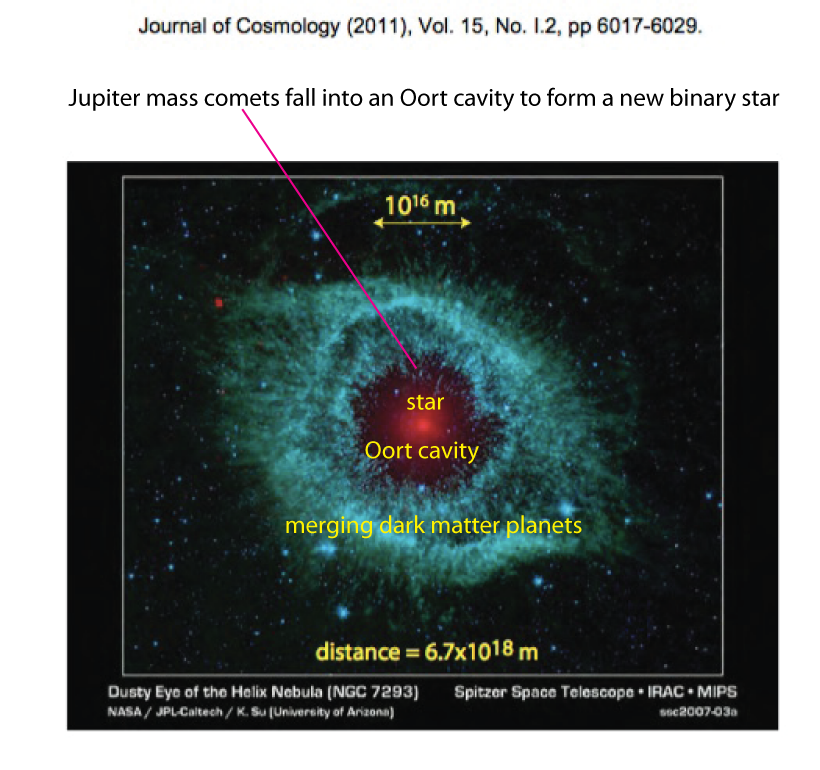
Figure JC2016.44.1 shows merging dark matter planets forming a star in our nearest planetary nebula Helix. The helical form reveals plasma jets from the star causing mergers of the surrounding dark matter planets. A million stars can form within a PGC clump of dark matter planets, which has diameter ~ 10^18 m. The green glow of the merging dark matter planets is partly from the release of gravitational potential energy, and partly from nuclear burning of tritium and tralphium (^3He) when the planets become multiple Jupiter amd brown dwarf mass. Many authors, and NASA, believe superwinds from dying stars explain planetary nebula, which is backwards and misleading. Dark matter planets grow by binary mergers of growing dark matter planet mass from earth to multi-Jupiter. Huge mass losses from giant stars by superwinds is a myth. Stars more massive than ~ 1.4 solar (~ 10^31 kg) explode as supernova. Plasma jets from the central binary star carry a small amount of mass outward compared to the cometary mass flow inwards of Jupiters and brown dwarfs feeding the central star, which starts as a cold starless core (Tokuda et al. 2016), p 13785.
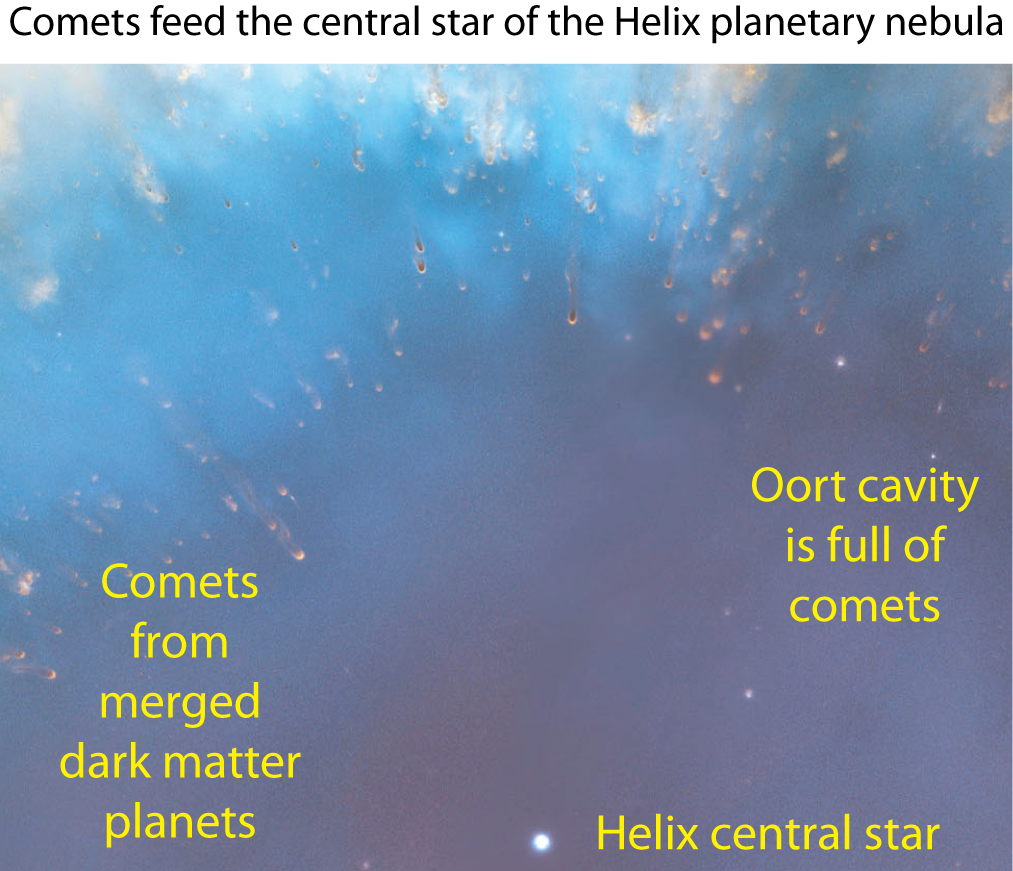
Figure JC2016.44.2 shows a closup view in the optical by the Hubble Space telescope of some of the larger comets from merged dark matter planets, obviously feeding the central star. These comets are likely multi-Jupiter mass. Many more appear in the infrared, but with lower resolution of their gas-dust wakes, p 13786.
45. Catastrophic Equatorial Icing events Crash Aircraft with Increasing Frequency, Carl H. Gibson, Turbulent Mixing and Beyond 2014, Workshop in Trieste, Italy, updated June 5, 2016, following comments of Referees. pp 13787-13794.
This paper has been moved to the Catastrophic Equatorial Icing-dedicated Volume 28
46. Star streams in a near-by galaxy reflect the freezing of its protogalaxy, Commentary by Carl H. Gibson on Delgado et al. 2008, pp 13806-13833.
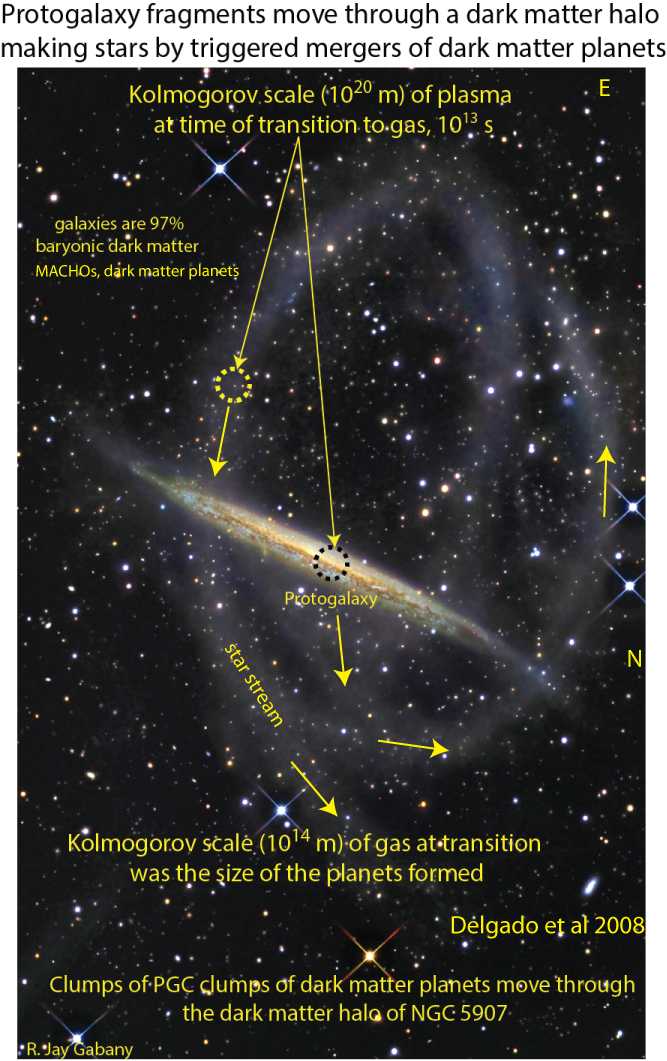
Figure JC2016.46.1. Star formation wakes. When the temperature of the universe falls below the 13.8 K freezing temperature of hydrogen, the hydrogen gas dark matter planets of proto-galaxies (PGs) begin to freeze. As the 10^14 m planet atmospheres shrink to 10^6 m, the PGC clumps of a trillion become nearly collisionless and diffuse to form the dark matter halo of the galaxy with diameter about 10^22 m. The non-baryonic-dark-matter (such as neutrinos) diffuses to at least 10^23 m. PGCs in the PG are the last to freeze because turbulence can develop with dark matter planets as the fluid particle, as seen in bright star formation. Finally, one or two massive clumps of PGCs emerge from the PG taking a significant fraction of its mass and its size of 10^20 m, as seen in the Milky Way in the formation of the Magellanic cloud galaxies, each with ~ 10^41 kg, or ~10% of the entire galaxy baryonic mass. As these objects pass through the BDM halo of PGCs, star formation is triggered to form the ghostly star streams, misinterpreted by Delgado et al. 2008 as wakes of accreting dwarf galaxies, p 13834.
47. "The dark matter halo of all galaxies is > 90% baryonic planets (MACHOs) in PGC clumps of a trillion.", Commentary by Carl H. Gibson on the preprint "A new look at microlensing limits on dark matter in the Galactic halo", by M.R.S. Hawkins, pp 13835-13843. Commentary with figures.
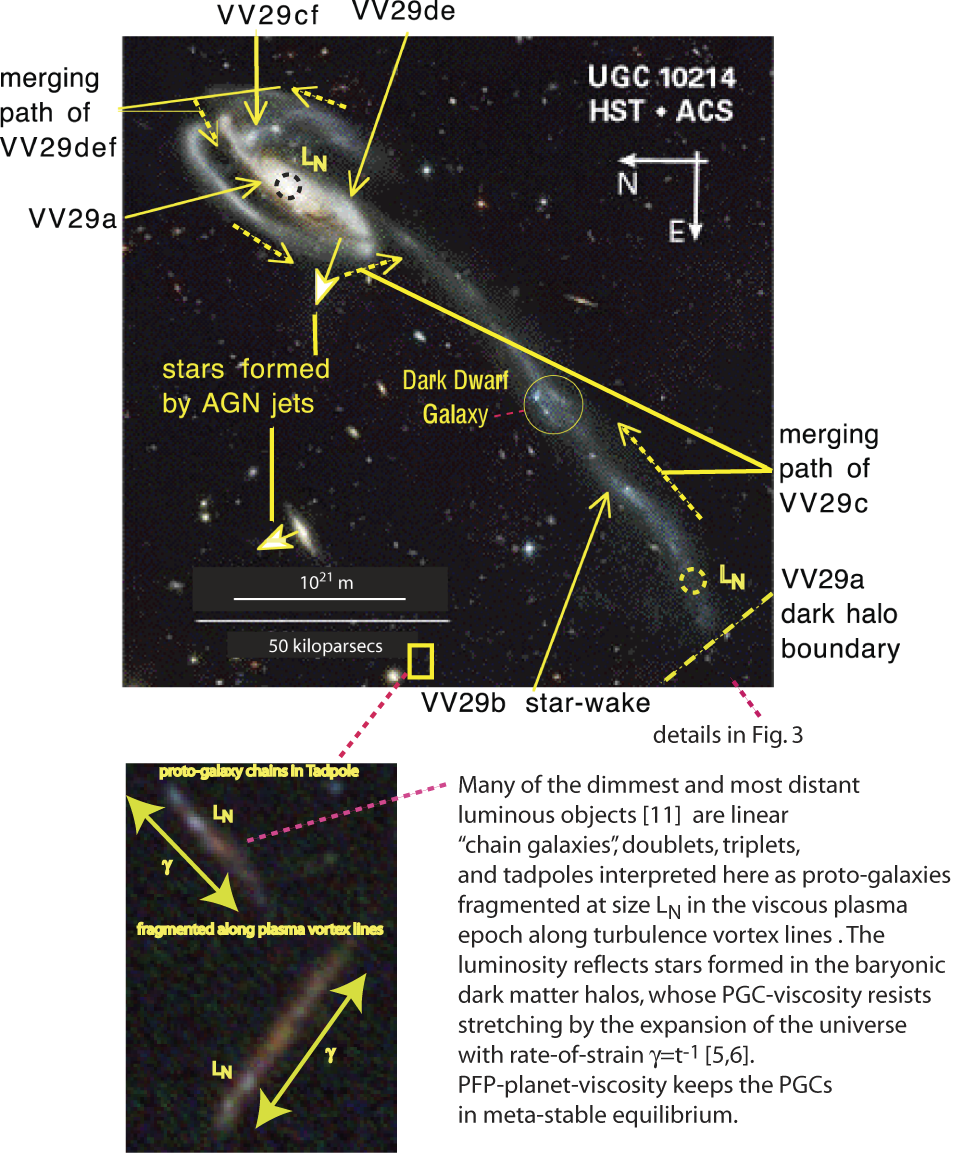
Figure JC2016.47.1. The Nomura scale L_N 10^20 m is the size of all Proto-Galaxies (PGs) and is shown by dotted circles in the figure. As shown in the yellow box, PGs fragmented along fossil turbulence vortex lines remnants of hot big bang turbulent combustion. Vortex lines were stretched by the expansion of the universe at rate gamma as shown by these very high resolution HST images, suggesting large fossil gamma values of the universe existed during the plasma epoch before redshift 1000 (300 Kyr). A sharp dark halo boundary is shown at 40 L_N where MACHOs in PGC clumps begin to form stars by these dark matter planet mergers within the PGCs. LCDMHC cosmology claims no stars or MACHO planets are formed before 300 Myr. All PGs have the same size L_N because they were formed at reshift 5000 (30 Kyr) when all properties of the plasma were smooth and uniform from the expansion of the universe and large kinematic viscosity (nu 10^26 m^2 s^-1), p 13844.
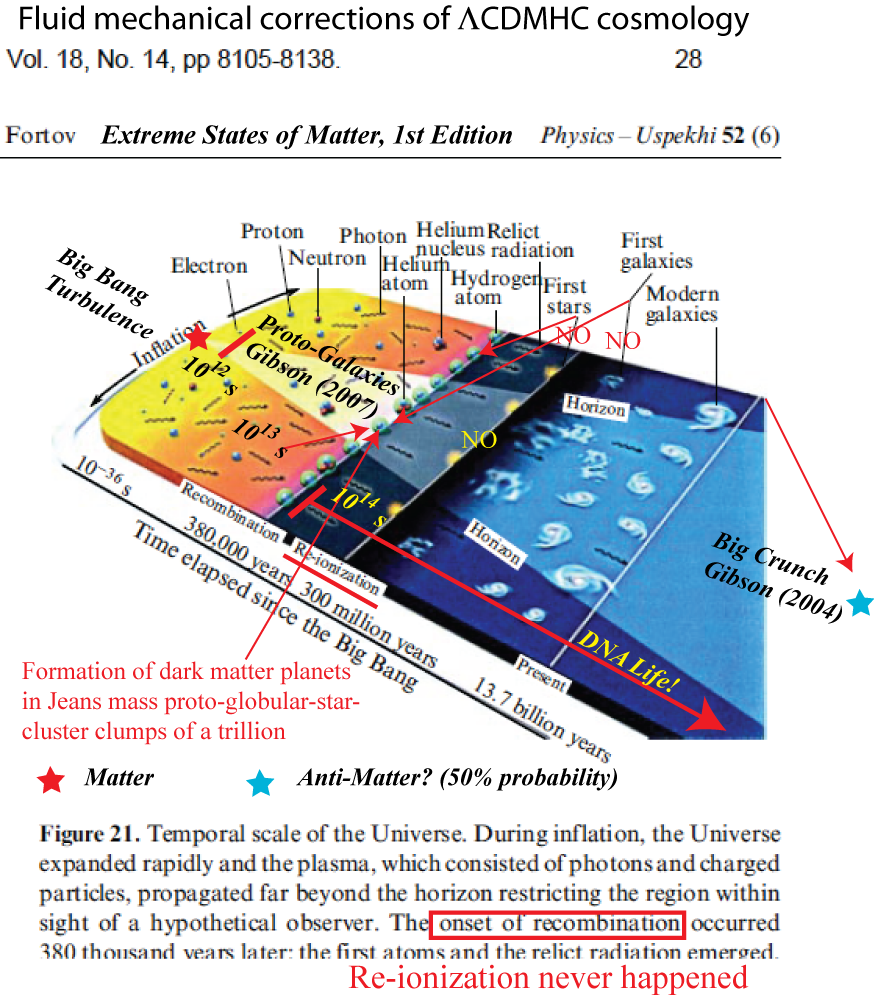
Figure JC2016.47.2. Extreme States of Matter 2nd Edition, V.E. Fortov, Springer. Carl H. Gibson corrections, for Fortov 3rd Edition. Life begins at 2 million years when water condenses on the dark matter planets. Gibson (2004) shows from collisional fluid mechanics that the big bang results from a turbulent combustion instability, and the resulting universe ends with a big crunch to resolve the thermodynamic problems intrinsic to dark energy and andigravity. Gibson (2007) develops hydro-gravitational-dynamics (HGD) cosmology to replace the LCDMHC model with improved versions of collisional fluid mechanics that include new turbulence (defined by inertial vortex forces) and new stratified turbulence (beamed-zombie-turbulence-maser-action BZTMA mixing chimneys) in radially stratified objects with magneto-hydro-dynamics MHD forces and quantum gravity. Observations of Schild (1996) and DNA extraterrestrial life evidence of Hoyle-Wickramasinghe cometary panspermia (1966-2016) support the figure, p 13845.